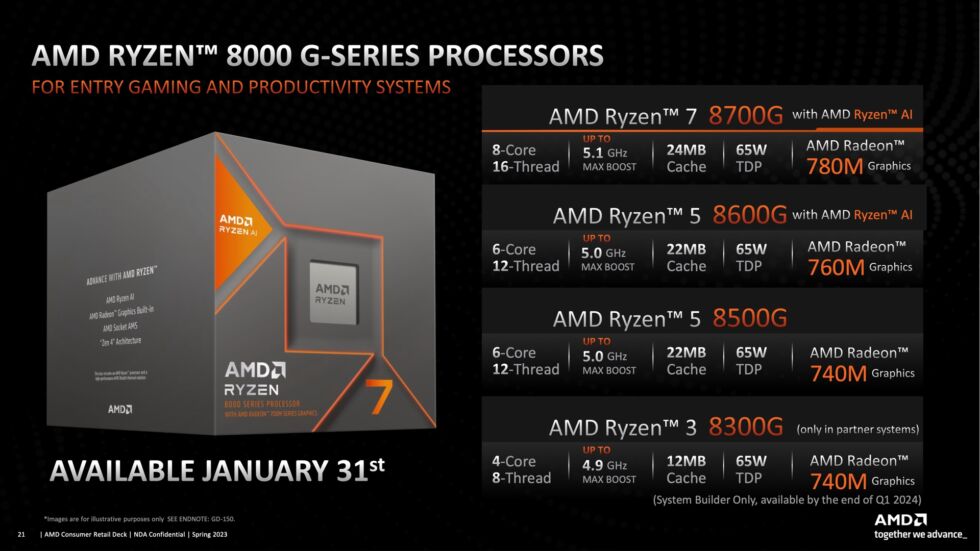
AMD
AMD’s G-series Ryzen desktop processors have always been a bit odd—a little behind the curve on AMD’s latest CPU architectures, but with integrated graphics performance that’s enough for a tiny and/or cheap gaming desktop without a dedicated graphics card. They’re also usually updated much more slowly than AMD’s other desktop Ryzens. Today, AMD is announcing a new lineup of Ryzen 8000G processors, chips that should provide a substantial boost over 2021’s Ryzen 5000G chips as long as you don’t mind buying a new socket AM5 motherboard and RAM to go with them.
There are three new processors releasing on January 31. The most powerful is the $329 Ryzen 7 8700G, an 8-core CPU with a Radeon 780M GPU. The next step down, and probably the best combination of price and performance, is the $229 6-core Ryzen 5 8600G, which comes with a slightly slower Radeon 760M GPU.
At the bottom of the range is the $179 Ryzen 5 8500G. It also includes six CPU cores, but with a wrinkle: two of those cores are regular Zen 4 cores, while four are smaller “Zen 4c” cores that are optimized to save space rather than run at high clock speeds. Zen 4c can do exactly the same things as Zen 4, but Zen 4c won’t be as fast, something to be aware of when you’re comparing the chips. The 8500G includes a Radeon 740M GPU.
The Radeon 780M uses 12 of AMD’s compute units (CUs), based on the same RDNA3 graphics architecture as the Radeon RX 7000 series dedicated graphics cards. The 760M only has eight of these CUs enabled, while the Radeon 740M uses four. All four CPUs have a TDP of 65W, which can be adjusted up and down if you have a socket AM5 motherboard with a B650 or X670 chipset.
| CPU | MSRP/Street price | CPU/GPU Arch | Cores/threads | Radeon GPU | Clocks (Base/Boost) | Total cache (L2+L3) |
|---|---|---|---|---|---|---|
| Ryzen 7 8700G | $329 | Zen 4/RDNA3 | 8c/16t | 780M (12 CU) | 4.2/5.1 | 24MB |
| Ryzen 7 7700 | $329 | Zen 4/RDNA2 | 8c/16t | Radeon (2 CU) | 3.8/5.3 | 40MB |
| Ryzen 7 5700G | $198 | Zen 3/Vega | 8c/16t | Radeon (8 CU) | 3.8/4.6 | 20MB |
| Ryzen 5 8600G | $229 | Zen 4/RDNA3 | 6c/12t | 760M (8 CU) | 4.3/5.0 | 22MB |
| Ryzen 7 7600 | $229 | Zen 4/RDNA2 | 6c/12t | Radeon (2 CU) | 3.8/5.1 | 38MB |
| Ryzen 5 5600G | $150 | Zen 3/Vega | 6c/12t | Radeon (7 CU) | 3.9/4.4 | 19MB |
| Ryzen 5 5600GT | $140 | Zen 3/Vega | 6c/12t | Radeon (7 CU) | 3.6/4.6 | 19MB |
| Ryzen 5 8500G | $179 | Zen 4 and Zen 4c/RDNA3 | 6c/12t | 740M (4 CU) | 3.5/5.0 | 22MB |
| Ryzen 5 5500GT | $125 | Zen 3/Vega | 6c/12t | Radeon (? CUs) | 3.6/4.4 | 19MB |
A fourth processor, the quad-core Ryzen 8300G, will be available exclusively through PC OEMs. Expect to see it in lower-end desktop systems from the likes of HP and others, but you won’t be able to buy it at retail. It uses one large Zen 4 CPU core and three small Zen 4c cores.
The Ryzen 8700G and 8600G are priced at the exact same level as the 7700 and 7600, which have the same CPU architecture and core count. If you’re trying to decide which one to buy, note that the Ryzen 7000 chips’ higher boost clock speeds and larger pools of cache will help them outperform the 8000G processors, so they’re the ones to get if you plan to install a dedicated GPU right away or you just don’t care about integrated graphics performance.

